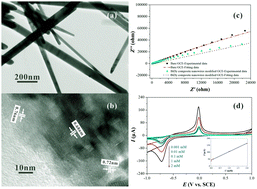Synthesis and properties of BiDy composite electrode materials in electrochemical sensors†
Abstract
BiDy composite nanowires were prepared via a facile method and characterized by electron microscopy, X-ray diffraction and X-ray photoelectron spectroscopy. The length and diameter of the composite nanowires are longer than 5 μm and about 20–100 nm, respectively. The obtained composite nanowires possess a poly-crystalline structure and are composed of tetragonal Bi2O2CO3, triclinic Bi2O3 and hexagonal Dy2O2CO3 phases. The formation process of the BiDy composite nanowires was investigated by controlling the growth conditions, such as sodium dodecyl sulfate concentration, reaction temperature and reaction time. The electrochemical performance of the BiDy composite nanowire modified glassy carbon electrode for the determination of L-cysteine was investigated using the cyclic voltammetry (CV) technique. A pair of semi-reversible electrochemical oxidation and reduction peaks towards L-cysteine at −0.73 V and −0.02 V, respectively are formed at the BiDy composite nanowire modified electrode in 0.1 M KCl and 2 mM L-cysteine solution. The BiDy composite nanowire modified electrode shows a wide linear range from 0.001 to 2 mM with a low detection limit of 0.21 μM. The BiDy composite nanowire modified electrode reveals good selectivity, reproducibility and stability. The proposed BiDy composite nanowires can be used as a promising electrode modified material for L-cysteine sensing.



 Please wait while we load your content...
Please wait while we load your content...